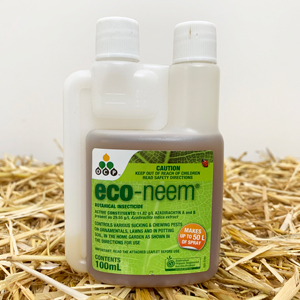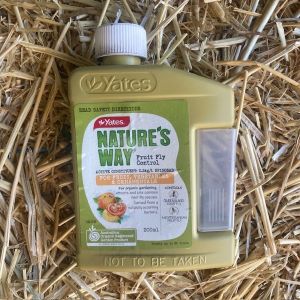| item(s), Total: $0.00 View Cart |
| Shopping cart is empty. |
Fruit Fly - Tips for Organic Control in the home garden

Fruit fly are an incredibly annoying pest - they can destroy a range of fruit and vegetable crops in a very short space of time. It is heartbreaking to be nurturing a fruit tree for years, sustained by the anticipation of your first juicy fruit only to have your dream shattered by a tiny, flying bug and its larvae.
If you grow fruit, it is actually your responsibility to actively control fruit fly in your back yard. The Ag Department can enforce this, particularly if you are located near commercial growers.
Unfortunately Fruit Fly are very difficult to control using purely organic methods; however you CAN help keep numbers down, and we will try and give you a few ideas which should help you enjoy the fruits of your labour (excuse the pun).
Know Your Enemy
 Queensland Fruit Fly were eradicated from Perth in the 1990's, (although we have had other, more recent outbreaks - thankfully successfully controlled) and we need to be vigilant to ensure we remain free of them. The common Fruit Fly we get here in the west is the Mediterranean Fruit Fly (Medfly - see picture), thought to originate from tropical Africa, and was first detected in WA in Claremont in 1895.
Queensland Fruit Fly were eradicated from Perth in the 1990's, (although we have had other, more recent outbreaks - thankfully successfully controlled) and we need to be vigilant to ensure we remain free of them. The common Fruit Fly we get here in the west is the Mediterranean Fruit Fly (Medfly - see picture), thought to originate from tropical Africa, and was first detected in WA in Claremont in 1895.
The activity of Medfly depends on the temperature. In late spring, summer and autumn they are most active around Perth. Over winter, the fly may become inactive in the cold, however they can survive through this season in all stages of their life cycle, and when temperatures begin to warm up, new adults begin to emerge from their pupae in the ground, and surviving adults become active. Adult Medfly typically live for 2 - 3 months and are often found in foliage of fruit trees. As long as fruit is available, they tend not to spread further than 20 - 50 metres from their place of origin.
After mating, females will search for a suitable host in which to deposit her eggs. Soft fruit (such as apricots) are more preferable than harder fruits like apples and pears, but where populations are higher or there is a lack of preferred fruit, a much wider range of fruits can be infested.
The Larvae (maggots) will hatch within 2 - 4 days. These little white grubs start out 1mm long but grow to about 8mm long, and are what most people recognise as fruit fly. Their activity causes fruit to rot and spoil. Once fully grown, the larvae leave the fruit, and burrow into the soil to pupate. The pupae resemble a small brown capsule about 6mm long. The pupation stage varies with temperature - it lasts around 2 weeks in summer, and can be about 7 weeks over winter. Eventually the adult emerges from the pupal case and burrows up through the soil.
Here are the main methods to control Medfly:-
Coversprays
These are non-organic and I believe there are only three commercial insecticides registered for use in Western Australia. Cover sprays are non-selective pesticides; so for this reason their use is declining and alternative methods being increased - however for highly susceptible crops to be commercially viable, they are still used.
While we always recommend organic gardening methods, in extreme cases we recognise it may be necessary to use pesticides. Hopefully once you have a severe outbreak under control, in future years you can practice less drastic control methods.
ALWAYS read labels, follow instructions concerning withholding periods and NEVER use more than the recommended application rates.
Foliage/Spot Sprays
The spray is NOT applied to the fruit, but on the trunk or foliage of the tree. It is claimed that spraying on 1m2 area of foliage, or on a board which is then hung in the trees will control fruit fly for a 50m2 area. These sprays contain a fruit fly specific protein attractant, and an insecticide which will kill the fruit fly when it eats the protein.
We stock Yates Nature's Way Fruit Fly Control. It is certified organic, and has no withholding period.
Traps
A number of different types of traps and baits are available for Medfly. Some are pheromone based and will attract either males or females, depending on the product. Other baits or traps are based on a food source, and will attract both sexes, and possibly a number of other insects (both 'good' and 'bad') which will also die once captured.
Traps can contain a bait and an insecticide, or they can be a simple 'wet' trap, where insects enter but then cannot find their way out, and will eventually drown in the solution.
Traps are not considered to be hugely successful in controlling large numbers of Medfly, but they will certainly HELP, and can also help show the numbers of Medfly around, so if you DO choose to spray, you can do so at the most effective time.
 Commercial traps and baits are available to purchase (we have both available in stock); or you can very simply make your own; as per the diagram below. (The diagram shows a 2L bottle with handle - but any plastic bottle will do!)
Commercial traps and baits are available to purchase (we have both available in stock); or you can very simply make your own; as per the diagram below. (The diagram shows a 2L bottle with handle - but any plastic bottle will do!)
What you choose to use for bait is up to you. If you look on-line, there are a huge number of suggested recipes, many of which can be made from things you will already find in your cupboard. Here is one to try:
1L hot water
1/2 tblspn Cloudy Ammonia (available at supermarkets in the cleaning section)
1/2 tspn Vanilla Essence
100gm Sugar
1 tspn Dishwashing Liquid
1 tspn Vegemite
Dissolve the sugar and Vegemite in the hot water. Allow to cool before adding in remaining ingredients and mixing. Makes enough for approx. 3 - 5 traps.
Use between 3 - 6 traps in and around each tree (hang amongst the foliage), and replace the baits every two weeks at least, or if they become full of flies, or the liquid evaporates too quickly. Baits which are too low or diluted with rain will be less effective. If you are using a non-toxic bait, you can dispose the trap contents into the chookpen - fowls are quite appreciative of the protein!
Traps can also be placed in non-fruiting trees, and this can be an effective way to keep the flies away from your precious fruit too!
Exclusion Bags and Netting
Exclusion bags are available in a wide range of types and sizes - we often have them in stock so check in with us! Completely organic, they prevent the adult fruitfly from getting to the fruit to lay her eggs - if used at the right time (again, you may find traps helpful as an indicator). Exclusion bags also prevent sunburn of fruit, and are re-useable.
Netting trees with insect netting or by using old net curtains is also effective, providing you can cover the tree to ground level. This method has the added benefit of keeping birds away from fruit, but is only practical where you have a small to medium tree that you can easily cover. At GLSC, we carry insect netting packs in varying sizes.
The other way to use netting, or soft flywire, is to simply cover selected branches - think Christmas bon bons! Ensure you join all edges together well - you only need a tiny gap to allow the flies access.
Good Housekeeping
Simple, cheap - but why is it common to see fallen fruit left to rot at the base of a tree? This soft fruit is easily available for adults to lay eggs, and will allow numbers to explode. When picking up fruit that has been struck with Medfly, don't bury it or put it straight into the compost. The eggs and larvae can survive. Freezing, cooking or pureeing the fruit will destroy the Medfly (and the fruit can then be fed to chooks). Soaking in water too will work, however the larvae can survive for weeks. It is recommended to add a thin layer of kerosene to the water, to seal the water and prevent the oxygen exchange.
Alternatively put the fruit into a plastic bag (with no holes), tying it up securely, and leave it in the sun for a couple of weeks. The fruit will continue to break down, but it will also reach high temperatures which kill off the larvae. Check, and if no signs of life, the fruit can then be composted or disposed of. We have been shocked to find larvae still alive after 8 weeks.
Finally, select varieties of fruit which are less susceptible to fruit fly - either through type of actual fruit or by when in the season it ripens. Often, early ripening varieties are less affected simply because Medfly numbers tend to build up as summer goes on. Alternatively if you move to a property that has a fruit tree you don't want, either arrange to give the fruit away or have someone harvest it for you (there are often people who will be happy to exchange a load of fruit for a supply of jam!); or perhaps remove the tree and replace it with something else (preferably also green and alive). That way you won't be contributing to fruit fly numbers in your area and you won't have the worry anymore.
Using a combination of these methods will certainly help keep numbers of Medfly down, and you should be able to enjoy your own home grown fruit! Encourage your neighbours to do the right thing and control numbers too; otherwise all your hard work can be to no avail if your yard is continually being populated from over the fence! If they aren't keen gardeners, why not offer to make and check baits in their trees too - whilst being neighbourly it can also make a huge difference to your own harvest size!
Visit our online shop for Ceratrap baits, Nature's Way Fruit Fly Control, insect netting, and other pest control products.
Products for Fruit Fly Control
There several products from our product range that are perfect for fruit fly control in Perth. If you need help or advice to choose what’s best for you – please contact us today!
Get Growing Today!
Come on in!
Pick up bags or bulk product bring your trailer (or use one of ours) Opening hours: 8.30 - 4.00 Monday - Saturday (closed Sunday)
Shop Online - We Deliver
24/7 convenient & secure online shopping or support your local independent retail outlet
Get Growing
We guarantee our products. Ask our friendly staff for help & advice ~ we're here to help you achieve the garden of your dreams.


























